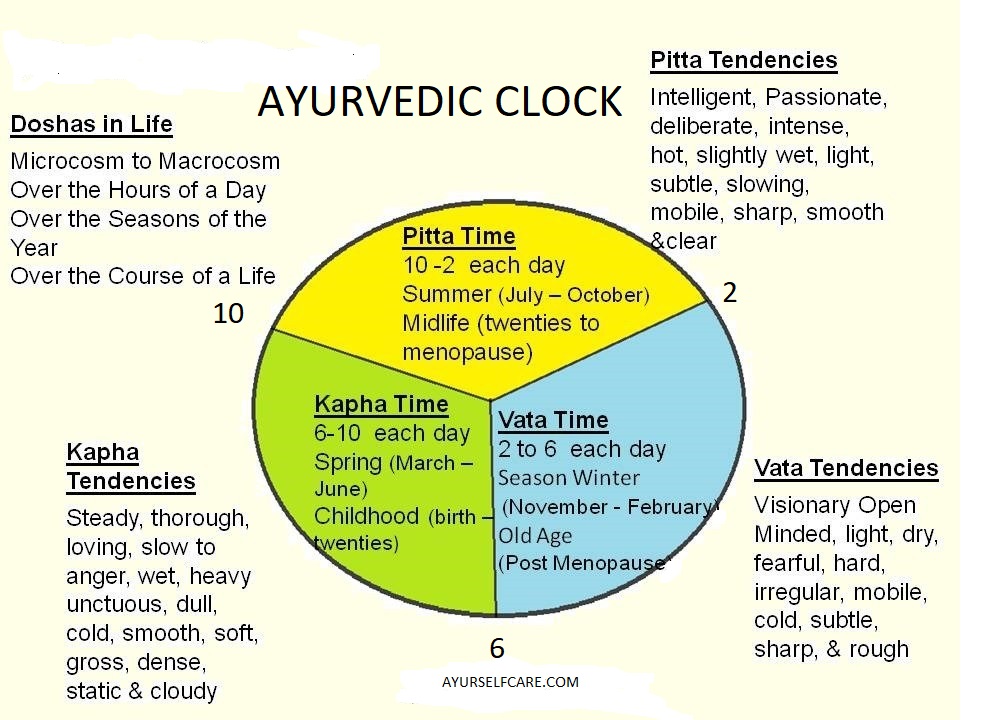
We are beings of rhythms and seasons. Aligning with flow supports health and enables ease. An Ayurvedic clock is a tool that shows you how to live in alignment with the forces acting most strongly at different times of the day. Life on the Ayurvedic clock helps optimize circadian rhythms and sets yourself up for success.
Why is this important? Very different than an alarm clock the Ayurvedic clock adds way more value sounding a buzzer to remind you and stress you out. This is not about oops you are late for a meeting.
The dominant dosha flows in a pattern from Vata to Kapha to Pitta each day and night. The passage of time and shifting of force, affects, shifts and shapes you. The clock shows this flow in a snapshot. The rhythms of our body set by the Circadian clock in our brain, are are supported by aligning with the larger rhythms of the dosha
Circadian Clock & Rhythms
Western biological studies of natural rhythms in animals and humans began late in the 20th century. In 2017 work to identify the structure the clock in the brain responsible for circadian rhythms captured the Nobel prize in physiology. Our body is managed, things like falling asleep, waking up, body temperature, blood pressure, and repair functions on circadian rhythms. If we go out of sync or our clock loses accuracy or stops working, it causes problems.
“Disconnection from circadian rhythms is called chronodisruption. It is linked to a host of health concerns, including poor cognitive function, mood and sleep disorders, daytime sleepiness, reduced school performance, substance abuse, heart disease, diabetes, obesity, and some cancers.” By Ganesh Puttur
https://www.artofliving.org/us-en/ayurveda-dinacharya-circadian-rhythm-of-your-body-for-optimal-wellness
Live In Alignment Follow Dinacharya
Now there is more understanding of how the flow of the dosha each day align with the rhythms of our bodies’ biochemistry. Ayurveda teaches us to live in alignment with the higher rhythms such as time of day, and balance the effects of dosha. As time goes on and research data shows that systems of the body run by circadian rhythms can work even better when we align with Ayurvedic teaching.
Let’s look at daily rhythms in more detail. Ayurveda divides the day into Vata, Kapha and Pitta time as represented on a clock. Air and ether combine in Vata, it is the force of dispersion. Kapha based on earth and water builds structure and Pitta with its fire and water digests and transforms. Gunas, qualities in the ten pairs of opposites describe the actions of each dosha.
Samanya – Vishesha Principle
Like increases like according to Samanya Vishesha a treatment principle in Ayurveda, so hot added to hot makes it hotter. The opposite qualities balance each other cold added to hot makes it more temperate. This principle applied to these patterns of potency, dispersing for vata, building for Kapha and transforming for pitta, build specific bodily function and activities and act in opposition to others. Here is an example where Ayurveda and western understanding of circadian rhythm physiology connect and help each other.
Cortisol Level Shifts In Rhythms
One primary stress hormone in the body is cortisol. Blood concentration of cortisol builds overnight and peaks early to meet the demand of the day. Cortisol is critical for healthy living.The suprachiasmatic nuclei in the hypothalamus track time each day to stimulate adrenal gland to maximize blood cortisol concentration during Kapha time each morning. Cortisol is a “getup and go” hormone just what you need in the Kapha the slowest moving time of day
AM Vata Time
Waking before 6 am in Vata time the lightest most spacious time is Ayurveda’s recommendation. Waken during Vata time when cortisol is rising to support alertness. Early rising allows you to tap into the connection to spirit and creativity of vata. Spend some time each morning connecting to your higher self before the worries of the world impact your day.
Cortisol is highest in Kapha time perfect for morning exercise. Peak cortisol level gets you moving to create positive stress to balance the earth and water in Kapha. Kapha time is also an ideal time for hot water or a light meal that is easy on the digestion.
Cortisol concentration levels out during pitta time to keep the body focused and stable to transform inputs from the world to self. Pitta time is the time to churn out work that needs intense focus and have your main meal of the day from 10 am to 2 pm each day. The dosha and corresponding gunas shift again as you move into late afternoon vata time.
PM Vata Time
Later in the day during vata time cortisol levels fall. Lower blood concentration in Kapha time allows the body to begin to relax and prepare for restful sleep and repair. Ayurveda says go to bed before 10 pm in Kapha time the perfect energy to slow down spend time in community and go to sleep.
If you get out of sync with daily rhythms burn the candle at both ends, this imbalance you dosha and can disrupt your circadian rhythms over time. Live in alignment with the daily rhythms set on the Ayurvedic clock to support your own health and success.
This article is not a substitute for professional medical care, treatment, or advice. All the material here is for learning purposes only. Always share strategy and work with your health care team.
